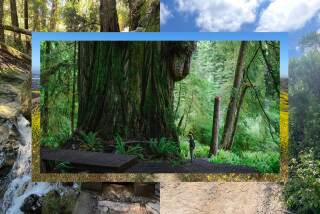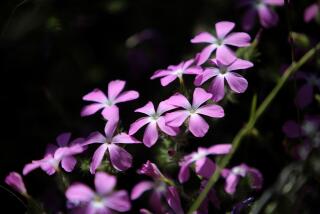Diverse Landscape Flourishes at Anza-Borrego Desert Park
Anza-Borrego Desert State Park includes virtually every feature visitors associate with a desert--washes, badlands, mesas, palm oases and a thousand more. Anza-Borrego is diverse, and it is huge; more than three times the size of Zion National Park. The 600,000-acre park stretches almost the entire length of San Diego County’s eastern border between Riverside County and Mexico. It ranges from 100 feet below sea level near the Salton Sea to 6,000 feet above sea level atop San Ysidro Mountain, and offers visitors a desolation that many find appealing.
While the park is oriented toward exploration by vehicle, a number of fine hikes await the desert trekker. Plan a stop at the park’s excellent visitor center (open 9 a.m.-5 p.m. daily) in Borrego Springs. For camping and wildflower information, as well as weather conditions, call (619) 767-4684.
One enjoyable day hike, for more experienced hikers in good condition, explores two canyons--Bow Willow and Rockhouse--and offers a nice introduction to the park.
A turn-of-the-century miner, Nicolas Swartz, boasted that he took $18,000 worth of gold from his remote desert mine. In the great tradition of Lost Mine legends, he died without leaving a map. In 1906, Swartz built a rock house in an anonymous canyon that soon picked up the name of his structure. Its history is a muddled affair. There are two rock houses in the state park, and there’s some question as to which actually belonged to Swartz. Some local historians believe that Swartz located his house in Nicolas Canyon on the other side of the park and say the Darrel McCain family built the rock house in Rockhouse Canyon as a line shack for a cattle operation.
This looping day hike takes you climbing through a single palm canyon, visits the rock house and its canyon and returns via the wash on the bottom of Bow Willow Canyon. Spring scatters color in the wash. Monkey flowers and desert stars and a host of wildflowers brighten the sands and gravel bars. Even ocotillo changes its fit-only-for-firewood appearance and displays its new green leaves and flaming red flowers.
Directions to the trail head: From Interstate 8 in Ocotillo, take County Road S-2 for 16 miles to the turnoff for Bow Willow Canyon and Campground. Follow the good hard-pack sand road 1 1/2 miles to the campground. Park in the campground, but don’t occupy a campsite someone could use.
The hike: Walk up Bow Willow Canyon on the signed Jeep trail. Before you get much past the campground, make a 90-degree left turn (south) across a few hundred yards of wash to pick up the foot trail. One-fourth of a mile up the trail is a beleaguered young palm tree. You begin climbing steadily through a desert garden of granite boulders, agave and cholla cactus.
As you near Rockhouse Canyon, the trail descends briefly and intersects Rockhouse Canyon Jeep Trail. Follow the trail west for one mile to Swartz’s abandoned rock house. We can only pray that Swartz was a better prospector than architect. However, it’s the only shade around, so this is no time to quibble over aesthetics.
From the rock house, you follow a tentative foot trail that drops into Bow Willow Canyon. The wash on the canyon floor makes a unique hiking experience. In the wash, there’s less of that relentless creosote that gives so much of the desert its monotonous look.
Water, scarce as it is, is the dominant force here. Flash floods carry great chunks of rock down to the canyon bottom. Water sculpts the cliffs and has carved the great “V” you’re hiking in.
Coyote melon, bitter-tasting to humans and to the coyotes as well, dot the wash. The melons dry in the sun, and the gourds blow around the wash. I’m often seized with the urge to bat them around and play some kind of prehistoric ballgame.
Before long, you’ll come to a barrier across the wash preventing dirt bikers from ascending into the upper reaches of the canyon. Past the barrier, the canyon widens, and it’s an easy 2-mile hike over soft sand back to Bow Willow Campground.
Rockhouse Canyon Trail
Bow Willow Campground to Rockhouse: 7 miles round trip; 700-foot elevation gain.
More to Read
Sign up for The Wild
We’ll help you find the best places to hike, bike and run, as well as the perfect silent spots for meditation and yoga.
You may occasionally receive promotional content from the Los Angeles Times.






